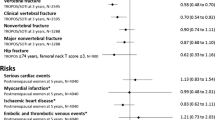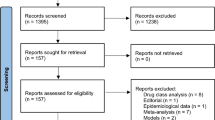Abstract
The phase 3 program for strontium ranelate, a new oral agent in the treatment of women with postmenopausal osteoporosis, was aimed to assess the efficacy and safety of the daily oral dose of 2 g. This program was conducted in 12 countries, involved 75 centers, and was structured in 3 studies: FIRST (Fracture International Run-in for Strontium ranelate Trial), SOTI (Spinal Osteoporosis Therapeutic Intervention study) and TROPOS (TReatment Of Peripheral OSteoporosis). FIRST, a run-in open study, was designed to start the normalization of the calcium and vitamin D status of the patients, check all entry criteria, and ensure inclusion of a sufficient number of well-motivated patients in either one of the two therapeutic intervention protocols, SOTI or TROPOS: FIRST included 9,196 patients. SOTI and TROPOS were prospective, randomized, double-blind clinical trials comparing, in two parallel groups, the daily oral dose of 2 g of strontium ranelate with placebo, the patients of both groups receiving calcium and vitamin D according to their own deficiencies. The main objective of SOTI and TROPOS was to demonstrate a reduction in the incidence of postmenopausal women experiencing a new osteoporotic fracture (vertebral fracture in SOTI and nonvertebral fracture in TROPOS) over a 3-year treatment period, the total duration of the studies being 5 years. SOTI included 1,649 women with at least one osteoporotic vertebral fracture at inclusion and a lumbar BMD ≤0.840 g/cm2. TROPOS included 5,091 women with a femoral neck BMD ≤0.600 g/cm2. The phase 3 program for the clinical development of strontium ranelate in women with postmenopausal osteoporosis is a long-term program with the main statistical analysis after 3 years of treatment. Its aim is to demonstrate the effect of strontium ranelate on the axial and appendicular skeleton as well as its tolerability in osteoporotic patients with replete calcium and vitamin D stores.


Similar content being viewed by others
References
Melton LJ 3rd. Who has osteoporosis? A conflict between clinical and public health perspectives. J Bone Miner Res 2000;15:2309–14.
Melton LJ, O'Fallon WM, Riggs BL. Secular trends in the incidence of hip fractures. Calcif Tissue Int 1987;41:57–64.
Johnell O. The socioeconomic burden of fractures: today and in the 21st century. Am J Med 1997;103(2A):S20–5; discussion S25–6.
Bengner U, Johnell O, Redlund-Johnell I. Change in incidence and prevalence of vertebral fractures during 30 years. Calcif Tissue Int 1988;42:293–6.
The European Prospective Osteoporosis Study (EPOS) Group. Incidence of vertebral fracture in Europe: results from the European Prospective Osteoporotic Study. J Bone Miner Res 2002;17:716–24.
Cummings SR, Black DM. Bone mass measurements and risk of fracture in Caucasian women: a review of findings from prospective studies. Am J Med 1995;98(2A):S24-8.
Melton LJ, Atkinson EJ, O'Fallon WM, et al. Long term fracture prediction by bone mineral assessment at different skeletal sites. J Bone Miner Res 1993;8:1227–33.
Black DM. Why elderly women should be screened and treated to prevent osteoporosis. Am J Med 1995;98(2A):S67-75.
Chesnut CH, Rosen CJ. Reconsidering the effects of antiresorptive therapies in reducing osteoporotic fracture. J Bone Miner Res 2001;16:2163–72.
Committee for Proprietary Medicinal Products (CPMP). Note for guidance on postmenopausal osteoporosis in women. London: EMEA, 2001.
Food and Drug Administration: Division of Metabolism and Endocrine Drug Products. Guidelines for preclinical and clinical evaluation of agents used in the prevention or treatment of postmenopausal osteoporosis. Draft, April 1994.
Reginster JY, Compston JE, Jones EA, et al. Recommendations for the registration of new chemical entities used in the prevention and treatment of osteoporosis. Calcif Tissue Int 1995;57:247–50.
Ettinger B, Black DM, Mitlak BH, et al. Reduction of vertebral fracture risk in postmenopausal women with osteoporosis treated with raloxifene. JAMA 1999;282:637–45.
De Groen PC, Lubbe DF, Hirsch LJ, et al. Esophagitis associated with the use of alendronate. N Engl J Med 1996;335:1016–21.
Marie PJ, Ammann P, Boivin G, et al. Mechanism of action and therapeutic potential of strontium in bone. Calcif Tissue Int 2001;69:121–9.
Arlot ME, Roux JP, Boivin G, et al. Effects of strontium salt (S12911) in both tibial metaphysis and epiphysis in normal growing rats. J Bone Miner Res 1995;10:abstract M415.
Canalis E, Hott M, Deloffre P, et al. The divalent salt S12911 enhances bone cell replication and bone formation in vitro. Bone 1996;18:517–23.
Su Y, Bonnet J, Deloffre P, et al. The strontium salt S12911 inhibits the expression of carbonic anhydrase and the vitronectin receptor in chicken bone marrow cultures and bone resorption in mouse calvaria and isolated rats osteoclasts [abstract]. J Bone Miner Res 1992;7(Suppl 1):S306.
Marie PJ, Hott M, Modrowski D, et al. An uncoupling agent containing strontium prevents bone loss by depressing bone resorption and maintaining bone formation in estrogen deficient rats. J Bone Miner Res 1993;8:607–15.
Boivin G, Deloffre P, Perrat B, et al. Strontium distribution and interactions with bone mineral in monkey iliac bone after strontium salt (S12911) administration. J Bone Miner Res 1996;11:1302–11.
Meunier PJ, Slosman DO, Delmas PD, et al. Strontium ranelate: dose dependent effects in established postmenopausal vertebral osteoporosis: a 2-year randomized placebo controlled trial. J Clin Endocrinol Metab 2002;87:2060–6.
Reginster JY, Spector T, Badurski J, et al. A short term run-in study can significantly contribute to increasing the quality of long-term osteoporosis trials. The strontium ranelate phase III program. Osteoporosis Int 2002;13(Suppl 1):P85MO.
Reginster JY, Diez-Perez A, Ortolani S, et al. Calcium–vitamin D supplementation in clinical trials of osteoporosis should be titrated on the basis of pre-study assessments. Osteoporosis Int 2002;13(Suppl 1):P65SA.
Reginster JY, Meunier PJ. Assessment of new non-vertebral osteoporotic fractures during a short-term run-in phase contributes to the internal validation of patients sample size calculations. Osteoporos Int 2002;13(Suppl 1):P78SU.
Fardellone P, Sebert JL, Bouraya M, et al. Evaluation of dietary calcium content by frequential calcium questionnaire. Rev Rhum Mal Osteartic 1991;58:99–103.
Genant HK, Wu CY, Kuijk C, et al. Vertebral fracture assessment using a semi-quantitative technique. J Bone Miner Res 1993;8:1137–48.
Marquis P, Cialdella P, de la Loge C. Development and validation of a specific quality of life module in postmenopausal women with osteoporosis: the QUALIOST. Qual Life Res 2001;10:555–66.
Adami S, Ortolani S, Wasnich R. Evaluation of therapeutic efficacy in osteoporosis. Osteoporos Int 1995;5:75–8.
Black DM, Reiss TF, Nevitt MC, et al. Design of the fracture intervention trial. Osteoporos Int 1993;3:S29-39.
Seeley D.G, Kelsey J, Jerkas M, Nevitt MC. Predictors of ankle and foot fractures in older women. J Bone Miner Res 1996;11:1347–55.
Chapuy MC, Arlot ME, Duboeuf F, et al. Vitamin D and calcium to prevent hip fractures in elderly women. N. Engl J Med 1992;327:1637–42.
Chapuy MC, Arlot ME, Delmas PD, Meunier PJ. Effect of calcium and cholecalciferol treatment for three years on hip fractures in elderly women. BMJ 1994;308:1081–2.
Chevalley T, Rizzoli R, Nyddeger V, et al. Effects of calcium supplements on femoral bone mineral density and vertebral fracture rate in vitamin D replete elderly patients. Osteoporos Int 1994;4:245–52.
Slosman D, Provvedini MD, Meunier PJ, et al. The use of different dual X-ray absorptiometry brands in a multicenter clinical trial. J Clin Densitom 1999;2:37–44.
Perron C, Tahintzi-Zawadynski S, Hans D, et al. Is multiple cross-calibration needed in a multi-center study? The phase III strontium ranelate program. Osteoporos Int 2002;13(Suppl 1):P366SA.
Meunier PJ, Slosman D, Delmas PD, et al. Strontium ranelate: dose-dependent effects in established postmenopausal vertebral osteoporosis: a 2-year randomized placebo controlled trial. J Clin Endocrinol Metab 2002;87:2060–6.
Machin D, Campbell M: Statistical tables for the design of clinical trials. Oxford: Blackwell Scientific, 1987;10:132–68.
Author information
Authors and Affiliations
Rights and permissions
About this article
Cite this article
Meunier, P.J., Reginster, J.Y. Design and methodology of the phase 3 trials for the clinical development of strontium ranelate in the treatment of women with postmenopausal osteoporosis. Osteoporos Int 14 (Suppl 3), 66–76 (2003). https://doi.org/10.1007/s00198-002-1341-8
Received:
Accepted:
Published:
Issue Date:
DOI: https://doi.org/10.1007/s00198-002-1341-8




